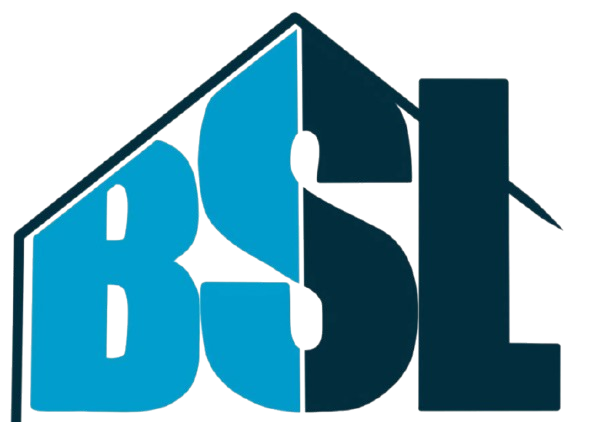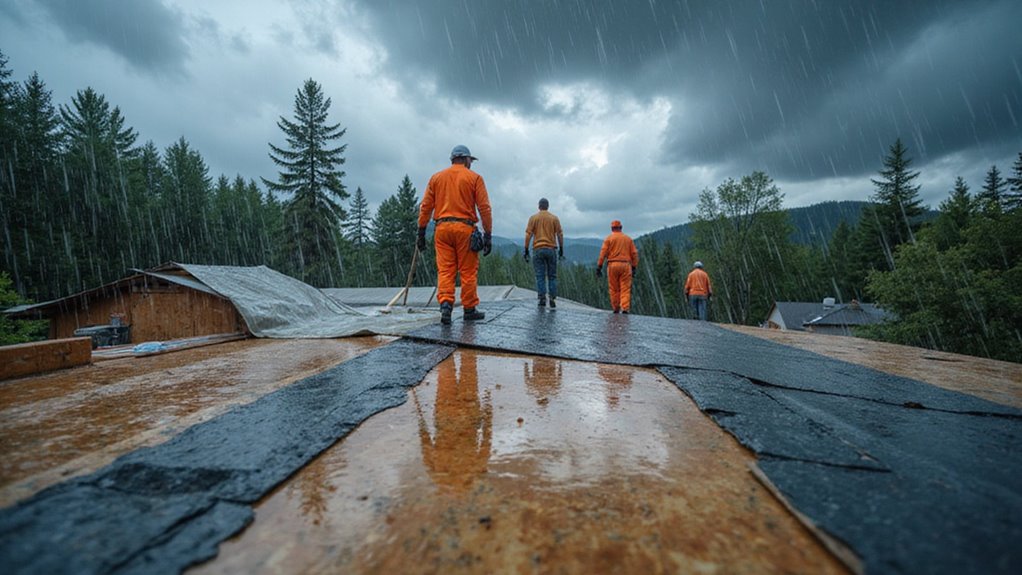Battling rain while replacing your roof can turn a routine project into a costly, dangerous nightmare. Standing water poses severe risks to both workers and roofing materials, threatening the structural integrity of homes. Wet conditions create treacherous working environments and compromise material performance, leading to potential failures. Smart homeowners and contractors wait for dry weather to ensure safety and quality installation.
Installing a roof during rainfall violates safety regulations and building codes, creating hazardous conditions. Professional roofers avoid working in active precipitation because moisture reduces material bonding and can cause long-term damage. Emergency temporary solutions like tarps should be used until proper installation can occur in dry conditions.
In this guide, I will explore everything you need to know about roofing installation and rain.
Key Takeaways
- OSHA prohibits roofing work during wet conditions due to severe slip hazards and increased workplace accident risks.
- Rain above 0.1 inches per hour stops roofing work; wet surfaces reduce material bonding strength by 40-60%.
- Moisture trapped during wet installation causes mold growth within 24-48 hours and voids manufacturer warranties.
- Emergency installations require strict safety protocols, temporary waterproof covers, and quick-sealing methods for exposed areas.
- Professional contractors use weather monitoring systems and flexible scheduling to ensure safe, code-compliant installations.
Is Roof Installation in the Rain Safe?
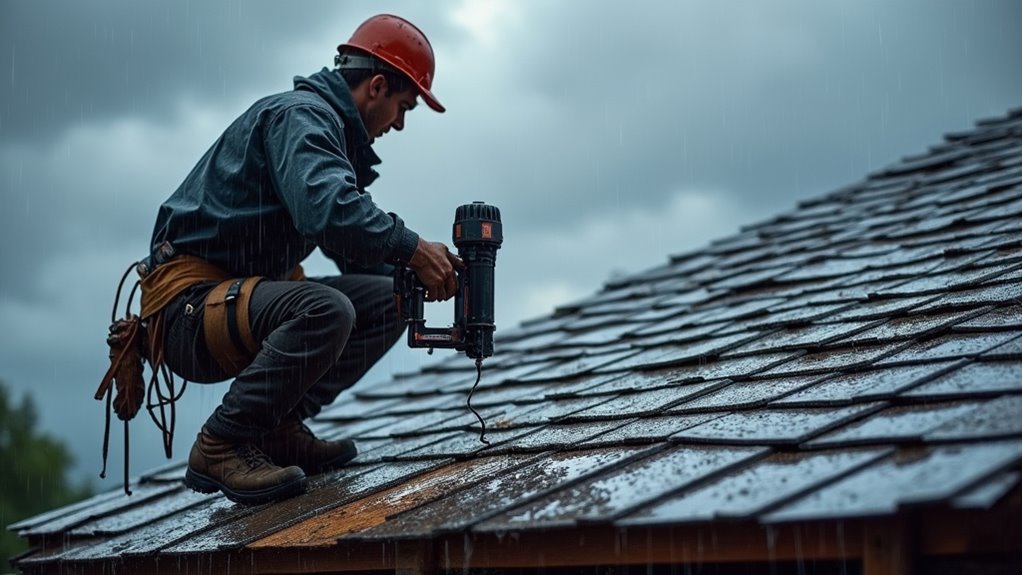
No, roof installation in the rain is not safe and should never be attempted. OSHA safety regulations strictly prohibit roofing work during wet conditions due to extreme slip hazards. Statistics show roofing already carries one of the highest workplace accident rates, even in ideal weather. Water creates dangerous working conditions and prevents proper material installation.
Furthermore, wet installations violate building codes and compromise roof quality. The International Building Code requires dry surfaces for proper roof material adhesion. Professionals must wait for clear weather to ensure worker protection and lasting results.
What are the Risks of Roofing in Rainy Conditions?
When you attempt roof installation during rain, you’ll face four critical risk categories that directly threaten both worker safety and building integrity. Wet conditions create hazardous work surfaces that violate OSHA fall protection standards, while concurrently allowing moisture infiltration into exposed structural components. Additionally, rain compromises the adhesion properties of roofing materials and creates ideal conditions for mold development—both of which can void warranties and violate Mississippi’s building code requirements.
Safety Hazards for Installers
Major safety hazards for installers include falls, slips, and equipment accidents. OSHA requires strict fall protection measures and safety equipment for all roofing work. Statistics show falls are the leading cause of roofing deaths nationwide.
Wet conditions create extreme dangers on roofs and demand immediate work stoppage. Slippery surfaces reduce traction and equipment grip significantly. Poor visibility in rain also increases accident risks.
To protect workers, supervisors must monitor weather and pause jobs during precipitation. Moreover, temporary protective measures like tarps help secure work areas until conditions improve. All installation work must follow OSHA safety protocols and local building codes.
Water Damage to Exposed Structure
Water exposure during roof installation causes severe structural deterioration and costly repairs. Rain seeps through temporary openings and soaks decking, insulation, and wooden frames. Moisture creates perfect conditions for mold, especially in Mississippi’s humid environment.
Building codes require completely dry conditions before installing permanent roofing materials. FEMA reports show significant property losses from installations during wet weather. The best protection comes from postponing work and using temporary tarps until conditions improve. Professional roofers must wait for dry weather to ensure proper material adhesion and structural integrity.
Compromised Material Performance
Water exposure causes severe damage to roofing materials during installation. Wet conditions prevent proper adhesion, leading to 40-60% reduction in material bonding strength. Rain creates lasting problems that impact roof durability and safety.
Three major issues affect compromised roofs: failed sealant bonds, trapped moisture blisters, and voided manufacturer warranties. Professional installers must schedule work during dry weather periods.
Building codes require completely dry conditions for proper roof installation. Smart scheduling protects homeowners from future leaks and structural problems. Quality installations create lasting protection against the elements.
Mold and Mildew Development
Moist environments enable mold and mildew growth rapidly in roofing structures. Harmful fungal colonies can develop within 24-48 hours when moisture becomes trapped. Wet conditions beneath shingles create perfect breeding grounds for dangerous spores.
Professional contractors must ensure complete surface dryness before installation. Temporary protective tarps help prevent water accumulation during delays. Additionally, damaged or wet materials require immediate replacement.
To maintain safety and warranty compliance, strict moisture control remains essential. Proper ventilation and regular inspections help detect early warning signs. These preventive steps protect both structural integrity and indoor air quality.
How Does Rain Affect Different Roofing Materials?
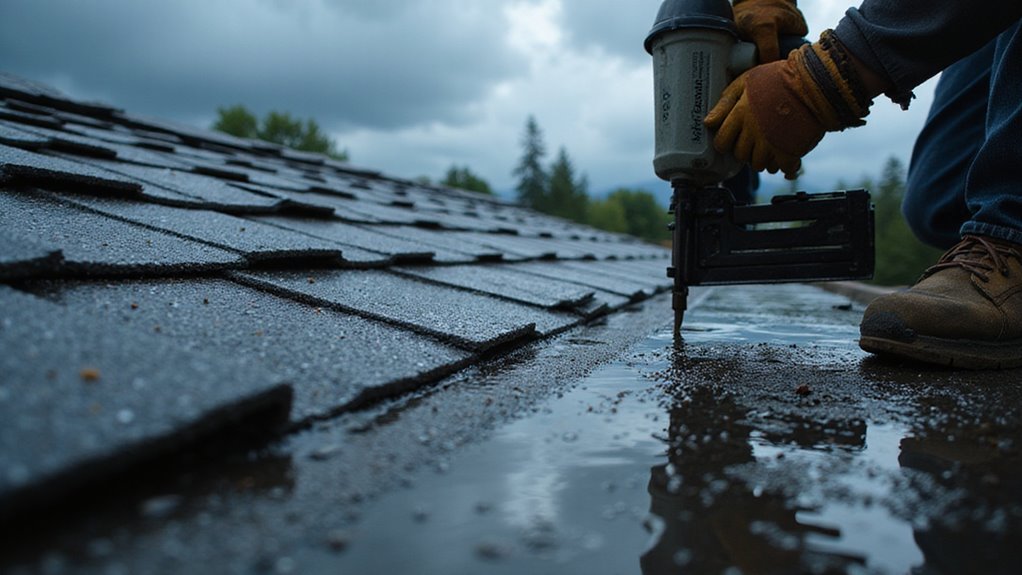
Rain affects each roofing material differently, and you’ll need to understand these distinctions to maintain code compliance and prevent installation failures. Asphalt shingles lose adhesive bonding capacity when wet, while metal roofing systems require dry substrates to prevent trapped moisture and corrosion. Tile, slate, and flat membrane installations each present unique moisture-related challenges that can compromise structural integrity and violate International Building Code standards if you proceed during precipitation.
Asphalt Shingles in Wet Conditions
Wet Conditions Are Dangerous for Asphalt Shingle Installation Moisture makes asphalt shingles unsafe and ineffective for installation. Water prevents proper adhesion between shingle layers and the roof deck. A minimum of 24 hours of dry conditions must occur before installing new shingles.
Problems arise quickly with wet installations. Trapped water creates mold beneath the shingles. The expanding moisture causes blisters and buckles in the material. Most importantly, self-sealing strips cannot form proper bonds.
Professional roofers must wait for completely dry conditions. This approach ensures lasting protection and maintains manufacturer warranties. Additionally, proper installation helps avoid expensive repairs later.
Metal Roofing Installation Requirements
Metal roofing requires specific installation conditions for safety and durability. The substrate must be completely dry before panel installation according to Mississippi building codes. Never install metal roofing during rain or wet conditions.
Proper moisture control prevents serious problems like corrosion and mold growth. Crews must use OSHA-approved fall protection equipment on slippery metal surfaces. Furthermore, sealants need dry conditions to cure properly.
To maintain quality, contractors should document weather delays on permits. The safety of workers takes priority over rushed completion schedules.
Tile and Slate Moisture Sensitivity
Tile and slate are highly sensitive to moisture exposure during and after installation. Water penetration can weaken mortar bonds by up to 40% and prevent proper adhesive curing. Excessive moisture often leads to serious structural problems in underlayment materials.
Additionally, prolonged wetness causes unsightly white mineral deposits called efflorescence on surfaces. Installation should only proceed when moisture readings stay below 16% for at least 48 hours. This requirement ensures proper curing and prevents future water damage.
These precautions protect both materials and occupants from moisture-related failures. Proper moisture control delivers lasting, beautiful results.
Flat Roofing Membrane Challenges
Moisture poses major risks to flat roofing membrane installations. Building codes require substrate moisture readings below 19% before installation can begin. Professional installers must check weather forecasts and avoid installation during rain risks.
Heat and humidity create perfect conditions for membrane failure and costly repairs. Proper moisture prevention includes complete substrate drying and moisture meter verification. Manufacturers specify strict moisture limits that installers must follow for warranty coverage.
Furthermore, smart scheduling around weather patterns helps ensure successful installations. Each precaution protects the investment and prevents future problems.
When Should You Delay a Roof Installation?
You must delay roof installation when current or forecasted rain threatens worker safety, violates moisture-control standards, or compromises material adhesion per International Building Code requirements. Weather intensity—including precipitation rate, wind speed, and lightning proximity—directly impacts fall protection effectiveness and OSHA compliance on slippery surfaces. Evaluate forecast duration and seasonal patterns in Mississippi’s humid climate to schedule installation during dry windows that prevent mold growth and ensure warranty-compliant conditions.
Weather Intensity Factors
Weather intensity affects roofing work through three key factors. Rain levels above 0.1 inches per hour will stop roofing projects due to safety risks and building code violations. Strong winds over 20 mph mixed with rain create dangerous conditions for workers on wet surfaces. Proper safety equipment becomes less effective in these conditions.
Thunderstorm forecasts require immediate work stoppage and protective measures. Workers must follow strict evacuation rules. Contractors will secure loose materials and install temporary covers. Furthermore, all equipment must be properly stored until weather improves.
Forecast Duration Considerations
Weather forecasts guide critical timing decisions for roofing work. Contractors must check predictions for dry conditions 24 hours before and after installation. Clear skies ensure proper material adhesion and protect warranties.
Building codes require rescheduling when rain extends beyond a 48-hour forecast window. Brief showers may allow temporary delays with protective coverings. However, extended rainfall demands complete project postponement.
A reliable forecast helps prevent structural damage and safety issues. Smart scheduling based on weather patterns safeguards both contractors and homeowners. These precautions maintain installation quality and building code compliance.
Seasonal Timing Impacts
Weather significantly affects roofing project success and durability. Spring provides optimal 60-70°F temperatures for proper material adhesion and curing. The mild conditions allow crews to work efficiently and safely. Moderate rainfall helps identify potential leaks during installation.
Fall offers 50-65°F temperatures and low humidity, ideal for most roofing materials. Clear skies and stable weather patterns reduce work delays. These conditions ensure proper sealing and long-term performance.
Winter installations must stop when temperatures drop below 40°F to prevent material failure. Cold weather compromises adhesive bonding and shingle flexibility. Smart contractors plan around local freeze patterns.
How to Install a Roof in Light Rain if Necessary
If you must proceed with a roof installation during light rain, you’ll need to follow strict safety protocols and code-compliant moisture-control procedures to minimize risks. Your approach must include proper fall protection equipment, strategic use of tarps and barriers, and a systematic section-by-section technique that limits exposure time. Each phase requires immediate sealing methods and thorough post-installation documentation to verify compliance with Mississippi building codes and warranty requirements.
Essential Safety Precautions
Essential Safety Steps for Roofing Work Safety equipment and proper protocols prevent accidents during roofing tasks. Workers must use OSHA-approved harnesses and secure anchor points at all times. Non-slip boots provide critical traction on all roof surfaces.
Weather conditions determine safe working periods. Professional weather monitoring helps crews avoid dangerous situations. Teams should stop work when rain begins or winds exceed 20 mph.
Temporary waterproof covers protect exposed areas until permanent repairs begin. These barriers prevent water damage to interior spaces. Furthermore, proper documentation of weather delays maintains warranty coverage and permit compliance.
Proper Tarp and Barrier Setup
Proper tarp installation prevents water damage during roof repairs. Heavy-duty polyethylene tarps must be at least 12-mil thick for adequate protection. Secure tarps with 2×4 lumber battens every 3-4 feet through solid decking.
Overlap seams need a 6-inch minimum and should run against water flow direction. Coverage must extend 4 feet beyond damaged sections when protecting from rain. Regular checks of anchor points ensure continued protection.
As a result, complete documentation of materials and installation dates supports permit and insurance requirements. These steps create an effective temporary barrier system.
Section-by-Section Installation Technique
Section-by-section roof installation protects against moisture damage during light rain. Professional roofers break the job into small, manageable sections to maintain quality.
Each section requires complete drying before applying underlayment and shingles. Proper fastener placement ensures secure adhesion to the dry substrate. Protective tarps shield unfinished areas between work zones.
For safety and compliance, crews must use fall protection gear on wet surfaces. Local building codes require detailed moisture-control documentation throughout the installation process.
Quick Sealing Methods
Three fast methods seal roofs quickly during emergencies or installation. Self-adhering membranes create instant waterproof bonds in valleys and along eaves. Quick-set cement seals flashings and pipe boots within 15-30 minutes. Emergency tarps offer temporary protection for exposed roof decking.
The right sealing method depends on your specific roof area and urgency level. Professional roofers often combine multiple techniques for complete protection. Moreover, these solutions work effectively even in wet conditions.
Professional installation ensures proper adhesion and lasting results. Always keep emergency sealing supplies ready during storm season.
Post-Installation Inspection Requirements
A professional post-installation inspection must verify dry conditions and proper material application. Building inspectors require three key documentation steps within 48 hours of roof installation during light rain. Take clear photos to prove all deck surfaces were dry before adding materials. Record weather data each hour using certified measurement tools throughout the installation process. A qualified third-party inspector should examine adhesion quality and check for moisture issues. These official records protect homeowners and contractors from future disputes about rain exposure or installation quality.
What Emergency Solutions Exist for Unexpected Rain?
If unexpected rain threatens your roofing project, you must immediately implement code-compliant emergency measures to protect the exposed structure and comply with OSHA safety protocols. Your primary options include deploying temporary waterproof coverings like weighted tarps, halting work at a safe stopping point to minimize moisture intrusion, or contacting licensed emergency roofing services equipped for rapid weather-response scenarios. These solutions prevent building code violations, water damage, and hazardous working conditions until dry weather allows you to resume proper installation.
Temporary Covering Options
Three reliable options protect unfinished roofs during weather delays. Heavy-duty polyethylene tarps provide basic protection when properly secured with wood strips. These thick barriers block water effectively. A proper 6-mil tarp meets safety codes for temporary coverage.
As a better choice, self-adhering membranes stick directly to exposed roof decking. These specialized materials create a waterproof seal. Moreover, the membranes stay firmly in place during storms.
For extended delays, plywood sheets combined with tarps offer maximum protection. This dual-layer method reinforces the structure while keeping moisture out. The combination withstands severe weather conditions.
Partial Installation Strategies
Partial installation allows safe roof work during uncertain weather. Crews must stop all activities when rain begins and cover exposed areas with waterproof barriers. Proper tarping protects vulnerable spots where old materials were removed. Teams need to secure all tarps according to OSHA safety regulations.
Moreover, moisture creates serious problems under new materials. No underlayment installation can occur in wet conditions due to adhesion and mold risks. Regular weather monitoring helps teams plan work segments effectively.
Furthermore, careful documentation supports permit requirements. The focus remains on preventing water damage while maintaining worker safety until completion.
Professional Emergency Services
Professional emergency services protect your roof during unexpected rain with fast, reliable solutions. Licensed contractors arrive quickly to prevent water damage and structural issues. Mississippi Building Code prohibits shingle installation during rainfall.
Teams use heavy-duty tarps with secure anchors to cover exposed areas immediately. Expert technicians measure moisture content to ensure proper drying before work resumes. Meanwhile, crews monitor weather updates around the clock.
As a result, your property stays safe and dry until conditions allow proper installation. OSHA safety standards remain in effect throughout emergency protection work. Professional crews maintain full code compliance while protecting your investment.
How to Plan Your Roofing Project Around Weather
Planning your roofing project around weather conditions isn’t optional—it’s a code-compliance and safety requirement that protects both workers and your property. You’ll need to incorporate reliable weather forecasting tools, establish flexible scheduling protocols that account for Mississippi’s frequent thunderstorms, and ensure your contractor follows documented weather-monitoring policies. Proper planning includes seasonal climate considerations and written procedures for postponing installation when moisture or precipitation threatens to compromise adhesion standards and worker fall protection.
Utilizing Weather Forecasting Tools
Weather forecasting tools help contractors complete safe, code-compliant roofing projects. Professional forecasting apps provide precise temperature and precipitation data for ideal installation conditions. NOAA radar systems track incoming weather patterns up to 72 hours in advance.
Contractors must check local weather stations before starting any roofing work. Building codes require documentation of weather conditions during installation for permit compliance. Modern weather tools prevent material damage and ensure worker safety.
Mobile apps now send instant alerts about changing weather conditions. These alerts help maintain OSHA safety standards and warranty requirements. As a result, roofing projects stay on schedule while meeting all safety protocols.
Creating Flexible Installation Schedules
Flexible installation schedules require careful planning around weather conditions. Contractors must leave 2-3 buffer days between major installation phases to allow for unexpected storms. Spring and fall offer the most reliable windows for roof work in Mississippi.
Local building codes mandate moisture control plans before permit approval. Smart scheduling protects exposed materials and keeps crews safe during installation. The best contractors develop backup sequences for each project phase.
Moreover, real-time weather monitoring helps teams adjust quickly to changing conditions. Professional roofers schedule critical waterproofing tasks during verified dry periods. OSHA safety standards remain mandatory regardless of weather delays.
Seasonal Considerations for Mississippi Climate
Mississippi’s climate requires specific seasonal planning for construction and installation work. Weather patterns vary dramatically across seasons, with summer highs reaching 95°F and winter lows dropping to 30°F. The state experiences frequent thunderstorms from March through July. Project managers must plan around these weather challenges.
Proper preparation includes daily weather monitoring and backup plans. Local building codes require weather delay documentation for permit extensions. Smart contractors keep emergency supplies ready and maintain flexible scheduling.
Beyond basic precautions, successful projects need careful timing. Summer mornings offer ideal conditions for outdoor work. Winter installations should target mid-afternoon hours when temperatures peak.
Contractor Weather Policies
Weather policies protect workers and ensure quality roofing installation. Most contractors follow strict guidelines for temperature, rain, and wind conditions based on OSHA standards. A formal policy outlines safe working conditions and property protection methods.
Your contractor must provide written documentation about weather-related work protocols. Crews cannot work in temperatures below 40°F, during active precipitation, or when winds exceed 30 mph. Professional roofers use weather monitoring systems to track conditions.
Safety comes first in adverse weather situations. Contractors will pause work to maintain quality and prevent accidents. Local building codes require proper installation conditions to ensure warranty coverage.
Contact BSL Roofing for Weather-Smart Roofing Solutions in Long Beach
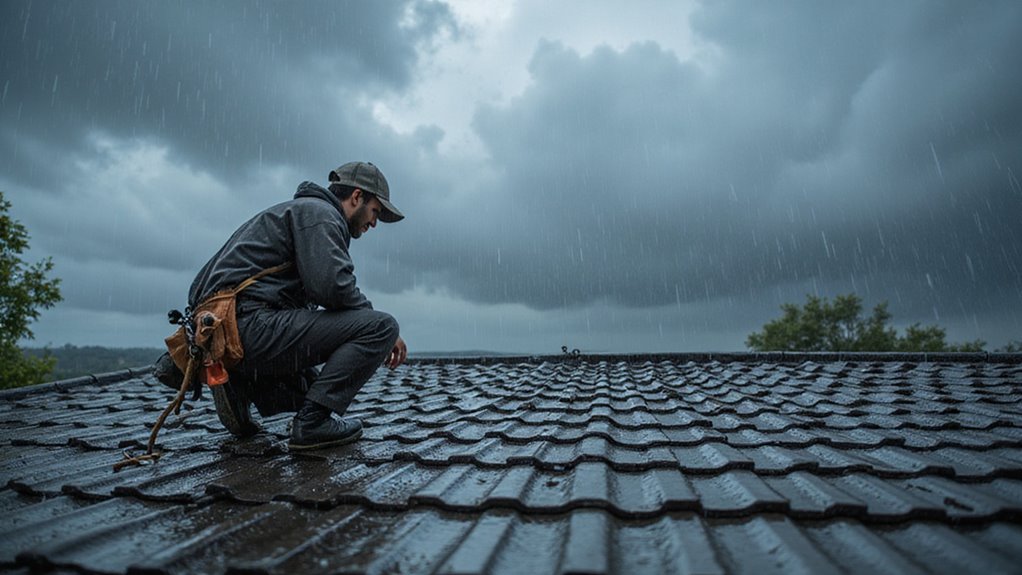
BSL Roofing helps Long Beach residents protect their homes during challenging weather conditions. Our team closely tracks weather patterns to ensure safe and compliant roof installations. Mississippi Building Code requires specific moisture levels during roof installations.
Professional weather monitoring allows us to make smart decisions about installation timing. A certified team deploys protective tarps when needed. Building permits require proper documentation of any weather-related installation delays.
Smart scheduling keeps your family safe and protects your investment from water damage. Moreover, our careful approach prevents mold growth and maintains warranty coverage. BSL Roofing puts safety first with each roofing project.
